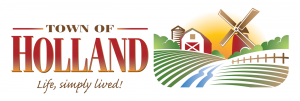About Town of HollandTown of Holland History
The Town of Holland began as a small community that formed along the banks of the Black River in 1850, in a burg referred to as New Amsterdam. The Town has grown from the first 86 Dutch settlers to more than 4,000 people today.
In the early years, New Amsterdam was a growing town that contained a ferry (established in 1853), general store (1853), post office (1855), saw mill (1857), blacksmith shop, stage coach station, hotel (1856), tavern (1856), church (1873) and a school house (1857). Today, the church is the only remaining building still in operation, leaving the growth of the township as mostly agricultural and subdivisions.
The first town meeting for the Town of Holland was held on the first Tuesday in April, 1858, at the school house near the Village of New Amsterdam. A town hall was built in Holmen in 1890 but apparently burned in 1906 or 1907. Another town hall was built and later sold to the American Legion for $300 in 1939. With the incorporation of the Village of Holmen in 1946, the Town of Holland sold the park, its accessories, the fire department and the hall to the Village (with the privilege of using it for elections and town meetings). However, beginning in the late 1970s, the Town of Holland saw significant population growth which lead to the purchase of land along the west end of McHugh Road in 1984 for the building of a new town hall. The new hall was completed in 1986 and a large park facility with two ball diamonds added in 1989.
An historic point of interest in the Town is the McGilvray bridges. In 1891, La Crosse County began building a turnpike and seven bridges across the bottomland on a route previously established by ferry boats. This road was abandoned in July, 1940 by the state and maintained by the Town of Holland for the next ten years at which time the seventh bridge was dismantled, thereby closing the McGilvray Road thoroughfare. Five of the seven bridges remain and have been named in the National Register of Historic places. The area is now home to hiking, fishing and wildlife viewing.
The Town is also home to Wisconsin’s Rustic Road R-64. Located near the Van Loon Wildlife Area and the McGilvray bridges, this route offers a rather unique combination of historic transportation, architecture and scenic views.
In addition to the historic McGilvray Bridges, there are over 8,000 acres of Black River bottom lands held by the Department of Natural Resources (DNR) and the Federal Department of the Interior for wildlife habitat. In addition to canoeing, fishing and hunting the Black River, other recreational areas include hiking or biking along the Holland Bike Trail and enjoying the eight neighborhood parks sprinkled throughout the Town. Open space is also being preserved through conservancy. Currently, there are over 400 acres held by the Mississippi Valley Conservancy (MVC) with an additional 61 acres of river terrace prairie land purchased in 2005 cooperatively between the MVC, Town of Holland and the DNR.
Part of the rural flavor in the Town of Holland is the family farms rolling into beautiful bluff lands used for hunting and hiking. The Town encompasses approximately 46 square miles and shares its borders with the Village of Holmen to the east, Town of Onalaska to the south and the Town of Farmington to the northeast. With growth, the Town has sought to balance between development and maintaining its rural character. Residents choose to reside in the Town of Holland because of its rural flavor, open space, exceptional school system, regional economic opportunities and accessible recreational sites.
